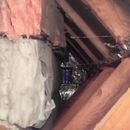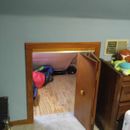Attic venting and insulation for an old 1 1/2 story Cape home
Hello all,
I’ve been reading this site for a while in hopes i’d find exactly the answers to my problems (I and/or my home have many)… But it was always bits and pieces and the specific advice didn’t always sync up and so I’m hoping that finally taking the time to outline my issues can find answers and peace of mind i’m looking for to ensure I take the correct steps with my home going forward.
Basically, I have “inherited” my in-laws 1 1/2 story cape cod home which was originally built in the 40s. it is our main residence and on the smaller side (Sq ft wise). we live in northeast NJ so climate zone 4 or 5 ish depending on where the towns curve.
The first issue i noticed was the humidity and basement which had quite a bit of mold which needed remediation. It has since been remediated (Fall 2018) but am still unsure the best DEHUMIDIFIER I should purchase as the RH levels in my home are high.
caveat, is that this MAY be due to all of the air leakage that i have throughout… per an energy audit i had done it is quite leaky, basement, 1st and 2nd floor all around.
It may also NOT be due to that, and it could be just that my cinder block or concrete floor are allowing moisture through. (there is no outer wall or sub slab water proofing). I don’t want to focus on if actual water infiltrated the basement cinder blocks or anything as i’m going to try to continue on assuming that was not the case (inklings maybe it did, but haven’t been able to confirm since remediation was done)
But digressing back on point… I am looking at hiring a home energy audit company to do work in the home to help seal/insulate my house, but also need my roof to be redone showing signs of issues that its about time (more on the roof later)
When my home was remediated the attic was also checked and it looked like on the attic side roof decking there may be or had been some mold up there… they fogged the attic instead of invasively gutting my whole house and after basement was done and home re-inspected, mold levels were gone.
Currently in my attic, I have a ridge vent, have powered fan which stopped working automatically when attic reached 90 degrees per thermostat and now only goes on manually as well as 2 gable vents (1 on each side) located in the middle top of each side.
As i mentioned it is a 1 and 1/2 story cape house with the 2nd floor converted to living space via knee walls. This leaves me with corner crawl spaces on each side as well as a tight hatch space in the ceiling.
I’ve attached 3 pictures, 1 is a general birds eye view of the home to give you an idea and then 1 picture is from the ceiling hatch shooting across the house to a gable vent, and the last is just a picture of a knee wall opening to a crawl space corner.
Right now the entire attic is stuffed with fiberglass insulation, some kraft faced, some foil faced, some in plastic bags… the slopes that parallel living space walls are stuff as well, the whole thing is not air flow efficient…
my first project is going to be removing allof the insulation in my attic to save money before the energy audit contractor work come to reinsulate “properly”. I use quotations because as i mentioned i also need my roof redone.
the order of operations is important to me so that 1 job doesn’t cause issues with the previously done job
1) seal/insulate first = what appens when roofers need to replace decking that is rotted/moldy or damaged that had been sprayed with closed cell spray foam?
2) roof job first = what happens when the seal/insulate job needs to vent the 2 bathroom fans out of the roof instead of where currently going, just being left to vent into attic.
those are my 2 biggest concerns on the order, and is leading me to believe i should have my roof redone first and make sure that any/all roof decking will be good for when the seal/insulate job is done.
next is the issue of all of the different types of ventilation i have.
from the proposals i read and way i understand is that the team would be insulating closed cell spray foam along the roof slope rafters top to bottom… in my understanding, creating a closed attic and now part of the conditions space.
if this is the case do i want to have a ridge vent, will they just spray foam and close it? what about the powered attic fan? the fan is technically scheduled to kick on at 90 degrees in the attic, but if conditioned would never get that hot any more correct? And the gable vents, should i have them board those up and spray foam over them?
i guess if the answers are that i am to now have a closed cell conditioned attic i don’t want all or even any of that ventilation correct? and if that is the case then i want to make sure i tell the roofers to change the job to just remove the ridge cap instead of putting a new on, or to just remove the powered fan instead of replacing/fixing…
The other small issue is from the birds eye view and the “porch” add on you can see in the back. this is the only part of the house that has soffit vents, now while those soffit’s then run through the ceiling of the porch, when in crawl space of the attic where it would be assumed the venting leads to, there is no air flow it seems…. should i have the roofers remove soffits in that case assuming that the seal/insulation team will be covering with closed cell spray foam?
Lastly, is it possible or doable, to switch from Closed Cell Spray Foam to Dense Packed Cellulose for the different parts of the sloping rafters?
crawl space corners exterior rafter side = closed cell spray foam
sloped rafter with sloped ceiling = dense packed cellulose
attic sloped roof to ridge = closed cell spray foam
is that a thing or should i be questioning anything that isn’t 1 or the other all the way through?
please ask for any additional details that may help in explaining my predicament as I just feel like my case is quite niche and am just trying to balance a whole load of things from an air flow, energy efficiency, insulation ratings and moisture issues that my head is spinning. (i don’t always trust “professionals” who are the ones selling me the way to do things either)
Thanks so much!
GBA Detail Library
A collection of one thousand construction details organized by climate and house part













Replies
>"The first issue i noticed was the humidity and basement which had quite a bit of mold which needed remediation. It has since been remediated (Fall 2018) but am still unsure the best DEHUMIDIFIER I should purchase as the RH levels in my home are high."
空气密封地下室墙壁、窗台上一个基础d band joist is the first order of business. The second order of business is to air seal the attic (often easier said than done in a 1.5 story). Any 50 pint or bigger room dehumidifier should be able to keep up with the latent loads of a small-ish 1.5 story house's basement if there isn't major 24/365 stack effect infiltration drive.
如果你是重置屋顶的绝佳机会moment to install sufficient rigid insulation above the roof deck to go with an air-tight unvented approach. With a 1.5 story there is almost never a reasonable way to get both adequate air flow on the underside of the roof deck with a soffit-to-ridge venting and still come anywhere near code-minimum on thermal performance. In your case you have both the sloped ceilings as well as a couple of valleys blocking the vent channel. In climate zone 4A it takes a minimum of 30% of the total R above the roof deck to have adequate dew point control at the roof deck (or first condensing surface), in climate zone 5 it takes 40%.
So with 3" of polyiso above the roof deck (R18, derate to R15 for zone 5) that would be sufficient dew point control for up to ~R23 between the rafters in zone 5 up to R42 in zone 4. With 2x6 rafters filled with rock wool, cellulose or open cell foam that's perfect for either zone, and the gable ends & vents could be insulated and sealed up. If the rafters are 2x8s it's probably worth bumping up to 4" on the exterior foam if you're on the zone 5 side of the line.
How deep ARE the rafters?
hey thanks for the quick reply. I had to wait until i was home to double check. but it looks like they are only 6 inch deep rafters.
The basement is going to be air sealed along all sill foundation and joists definitely! (thought have not discussed insulating walls etc... (the walls had a drylock type paint put on by remediation company)
i wanted to see what it would cost to do a basement indoor waterproofing job. The company come in and they suggested a 110 pint unit (assumed the oversell) but was just curious if something like a SantaFe Compact 70 would be sufficient (i liked the idea of pulling it up into the rafters and "out of the way" as well as making sure the hose has enough downward angle for draining down into the sump pit. I always hemmed and hawed about positioning (basement is 2 part, 1 is unfinished with mechanicals and such and other side used to be finished before mold remediation, and will eventually re-finish again)
The very first thing I would do is figure out the moisture source(s) in the basement. Built in the 40s, the basement slab almost certainly does not have a moisture barrier under it and you can move numerous pints per day up and through the slab of even a small home.
See this GBA blog on the simplest way to test for moisture content in basement slabs://m.etiketa4.com/article/extending-the-reach-of-a-moisture-meter.
You should be able to find a BPI auditor who can do this moisture test.
Peter
谢谢你彼得。能源审计是有水分tool that had 2 prongs and would press against walls/floor. (not the same device as what you linked) it showed the walls were saturated, but not sure if that was false reading due to the drylock paint stuff the mold remediators had put on my walls.
either way, i have a sump pump that usually has water in it. (it isn't covered, as its quite old and have had differing opinions on how much moisture a sump pump adds)
i am going to try the seran wrap and tape experiment over next couple days to see.
on a dehumidifier, would a typical box store 50 pinter do? i looked at SantaFe Compact 70 to hang from rafter n drain into sump.
I have used both a standard "off-the-shelf" Energy Star rollabout dehumidifier and the Santa Fe Advance 100 in our basement. The latter is overkill for our space, but much quieter, more efficient, and I love being able to control it via my phone app. Also, I really like that you can use the 25-foot ethernet cable they provide to locate the sensor far away from the unit so that the unit is being operated by RH in the center of our basement space rather than cycling with the sensor right at the unit.
Big price difference though, of course.
Peter
I agree with the other posters about the basement. For your attic though, it’s easy to vent the bathroom fans outdoors which is something you definitely want to do. Best is to go out an exterior wall, next best is the roof. Don’t go out under a soffit. You’ll want the vents in before spray foaming so that you won’t have to cut through the foam. If at all possible, you want these vent runs to be made of rigid duct and not the flex stuff. Only use flexible duct if you absolutely have to since flex duct is more restrictive to airflow than rigid duct.
If you need to reroof, do that before applying spray foam. Replacing any sheathing after spray foam has been applied will wreck the spray foam (it comes out in chunks), and would need foam to be reapplied in any affected areas. Once you’ve converted your attic to conditioned space, you won’t need any attic vents since the attic will become part of your home in terms of the air space.
Bill
Thanks Bill. plan is to roof then do seal/insulation work.
How is the outside grade, downspouts, gutters?
Jonathan, the grading is not great. we virtually have no eaves and the gutter guards will be replaced when roof is redone i believe are part of the issue. they are the ones that look like an "S" almost and instead of rain coming down the brim and into the hole they tend to just dribble over the edge and in the front of hte house create puddles right by our foundation... added a picture of recent storm and the issue they are causing. hopefully with new gutter guards and redone roof this will alleviate this.
on the grading that is another issue... looking at the front of th ehouse, i need to re-grade the dirt on each front side, that isn't hard.
the left side slopes down toward the backyard but could do a bit better job to ensure it is more tilted away from the house.
the right side is the biggest issue. that is where the drive way is that leads to the backyard fence... I think from over time the driveway has sort of sunk and/or created a spot where rain will puddle at the bottom of the driveway where it meets the gate, right up against the house foundation. this is my numero uno next issue to tackle.
in the middle of the back yard gate there is a hole that has a leader / water drain that goes out the backyard... but if the water is pooling in the corner when its bad rains and not getting to the drain, i need to channel it better.
I am trying to see if anyone would concur whether putting a drain channel along the wall n turn to get it under my deck & fence to the drain out would be the best way to handle this. Otherwise i'd be repaving and regrading the driveway which i don't know if i have enough $ for that too. *Plus i have basement windows which are only 1 inch or so off the driveway basically making me nervous and/or just have to lower the other side much more making it a big paving project.